Have you ever wondered why so many dentists are now talking about the “All-on-X” dental implants? Walk into any modern dental clinic or browse an online consultation, and you’ll likely hear this term tossed around more and more. But what does it really mean — and why has it become such a game-changer in how we restore smiles?
Let’s take a step back and explore it together, in simple, human terms.
So, What Exactly Does “All-on-X” Mean?
At its core, “All-on-X” is a clever technique designed to give patients a brand-new set of teeth supported by just a handful of implants — and the “X” stands for the number of those implants. For instance, All-on-4 means four implants hold a full arch of teeth, while All-on-6 uses six.
Traditionally, replacing every missing tooth might have meant placing one implant per tooth — a costly and time-consuming process. But with this innovation, the dentist strategically positions a small number of implants in key spots to hold a whole full arch of fixed, natural-looking teeth. And they often do this at angles, which maximizes stability and makes the most of the available bone — even when that bone isn’t as dense as it used to be.
How Does It Actually Work?
It’s a fascinating blend of technology and artistry. Here’s a quick overview:
- Consultation and 3D Scan: Your journey begins with detailed digital images of your jaw, allowing your dentist to evaluate your bone structure and plan the implants precisely.
- Implant Placement: Four to six titanium implants are carefully inserted into your jawbone, acting as the anchors for your new teeth.
- Temporary Teeth (Same Day): In many cases, patients leave the dentist’s office the same day with a set of temporary, fixed teeth — often called “Teeth in a Day.”
- Healing and Osseointegration: Over a few months, these implants fuse with your jawbone, creating a solid foundation.
- Final Restoration: Once healed, a permanent, natural-looking arch of teeth is attached, giving you a confident, lifelong smile.
Why Are Dentists Embracing the “All-on-X” Approach?
The rise in popularity isn’t accidental; there are some pretty compelling reasons:
- Efficiency and Speed: Fewer implants mean less surgery, shorter recovery times, and faster results — all without compromising strength or aesthetics.
- Accessibility: No longer is bone density a strict barrier. Thanks to angled placement, even patients with some bone loss can qualify for this treatment—saving them from more invasive procedures like bone grafts.
- Predictability: With advanced digital planning and improved implant materials, dentists now achieve consistent, reliable results.
- Clearer Communication: “All-on-X” is straightforward and easy for patients to understand — a full set of beautiful, functional teeth supported by just a few implants.
- A Better Quality of Life: Patients often report improved chewing ability, clearer speech, a natural appearance, and a boost in confidence — all things that truly change lives.
Is “All-on-X” Right for You?
While it’s an excellent option for many, it’s not for everyone. Ideal candidates tend to be those missing most or all teeth in one or both arches, weary of removable dentures, and seeking a permanent, fixed solution. That said, a comprehensive evaluation of your bone quality, gum health, and overall medical condition is essential before moving forward.
Questions to Discuss With Your Dentist
Thinking about it? Here are some key questions to ask:
- How many implants (“X”) would be right for my situation?
- Will I need additional procedures like bone grafts or sinus lifts?
- Can I get temporary teeth on the same day as the implant placement?
- How long will my final, fixed teeth last?
- What kind of maintenance will I need to keep my new smile healthy?
The Bottom Line
“All-on-X” marks a new chapter in dental implant technology—one that’s simpler, faster, and more accessible than ever before. By combining cutting-edge digital planning with life-changing results, it offers a stable, natural-looking smile you can rely on for years to come.
If you’ve been told you need dentures or multiple implants, don’t hesitate to ask your dentist whether this innovative approach might be a better fit. After all, your smile is worth it.

